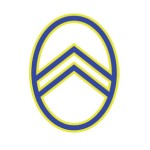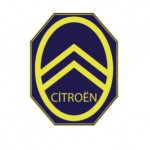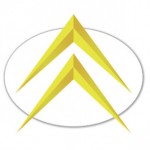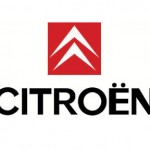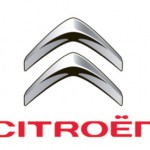
(English text below, after the logo gallery)
Die Pressemitteilung der Citroën Deutschland GmbH
(siehe auch den Amicale-Artikel vor 8 Jahren hier: https://amicale-citroen.de/die-amicale/citroen-logo/)
Der Doppelwinkel: Die Geschichte des Citroën Logos
* Idee von Firmengründer André Citroën und Basis seines Erfolgs
* Symbol für zwei ineinandergreifende Zahnräder
![]()
Wieso ist Citroën Logo eigentlich ein Doppelwinkel und was symbolisiert es?
Und wie hat sich das Logo in der mehr als 100-jährigen Markengeschichte verändert?
Bereits weit bevor Firmengründer André Citroën (1878-1935) mit der Produktion von Automobilen begann, lernte er im Jahr 1900 das Prinzip der Kraftübertragung durch Winkelverzahnung in der Firma seines Onkels in Warschau kennen. Nach seiner Rückkehr nach Paris erwarb er ein Patent über Getriebe und winkelverzahnte Zahnräder, wie sie beispielsweise in Mühlen zum Einsatz kamen. Bei solchen Winkelzahnrädern sorgte die spezielle Verzahnung für einen ruhigeren, leiseren und effizienteren Lauf. Jahre später gründete André Citroën ein Unternehmen, die sich auf die Fertigung von Untersetzungsgetrieben aus Stahl sowie von winkelverzahnten und spiralverzahnten Rädern spezialisierte. Zu seinen ersten Kunden zählten unter anderem Automobilbauer.
Als André Citroën 1919 schließlich selbst in den Automobilbau einstieg, um als erster Europäer Autos am Fließband zu produzieren, kam für ihn als Logo nur das Bild zweier Winkelzähne in Betracht, denen er seinen bisherigen Erfolg verdankte. Der Doppelwinkel symbolisiert also zwei Zahnräder, die ineinandergreifen.
Das ursprüngliche Logo der Marke Citroën zeigt einen blauen Doppelwinkel mit gelber Umrandung in einem Oval. Um Dynamik und Modernität zum Ausdruck zu bringen, erfuhr das Citroën Logo im Laufe der Jahrzehnte einige Überarbeitungen. Eine Besonderheit ist das „Moteur Flottant“-Logo, das in den 1930er Jahren im Einsatz war und einen weißen Schwan vor gelben Winkeln zeigt. Der Schwan symbolisiert die Motoren mit schwimmender Lagerung und findet sich auf bestimmten Citroën Rosalie als Kühlerfigur wieder. 1959 erfährt das Logo eine große Veränderung: Der goldfarbene Doppelwinkel ragt nun über ein weißes, liegendes Oval hinaus. Ab 1985 erscheint der Doppelwinkel in weißer Farbe vor einem roten Quadrat. Im Jahr 2016 folgt Citroën dem Trend der vereinfachten Linienführung und verpasst dem Logo eine Verjüngungskur – ganz im Sinne des „Flat-Designs”. Die neue Darstellung verleiht dem Doppelwinkel noch mehr Modernität und erhöht seine Sichtbarkeit deutlich.
Auch wenn sich Form und Farbgebung mehrfach änderten – der Doppelwinkel bleibt bis heute das unverkennbare Markenzeichen von Citroën.
Kontakt:
Christopher Rux
Leiter Presse und Öffentlichkeitsarbeit
Citroën Deutschland GmbH
+49 151 628 14 296
christopher.rux@citroen.com
—–
The press release of Citroën Germany – translation by Amicale
(and also see our article at https://amicale-citroen.de/die-amicale/citroen-logo/):
The History of the Citroën Logo
– Idea of company founder André Citroën and basis of his success
– Symbol for two intermeshing gear wheels
Why is the Citroën logo actually a double chevron, and what does it symbolise?
And how has the logo changed in the more than 100-year history of the brand?
Even long before the company founder André Citroën (1878-1935) began producing automobiles, he learned about the principle of power transmission by angular gearing in 1900 at his uncle’s company in Warsaw. After his return to Paris, he acquired a patent on gears and angular gears, such as those used in mills. In such angular gears, the special gearing ensured smoother, quieter and more efficient running. Years later, André Citroën founded a company specialising in the manufacture of steel reduction gears and angular and spiral gears. Among his first customers were automobile manufacturers.
When André Citroën finally entered the automotive industry himself in 1919, becoming the first European to produce cars on the assembly line, the only logo he could think of was the image of two angle teeth, to which he owed his previous success. The double angle thus symbolizes two gearwheels that mesh with each other.
The original logo of the Citroën brand shows a blue double angle with a yellow border in an oval. To express dynamism and modernity, the Citroën logo has undergone several revisions over the decades. One special feature is the “Moteur Flottant” logo, which was in use in the 1930s and shows a white swan in front of yellow angles. The swan symbolizes the engines with floating bearings and can be found on certain Citroën Rosalie as a radiator figure. In 1959, the logo underwent a major change: the gold-coloured double angle now protrudes above a white, horizontal oval. From 1985, the double angle appears in white in front of a red square. In 2016 Citroën followed the trend of simplified lines and gave the logo a rejuvenating treatment – in keeping with the “flat design”. The new design gives the double angle even more modernity and significantly increases its visibility.
Even though the shape and colour scheme have changed several times, the double angle remains Citroën’s unmistakable trademark to this day.
